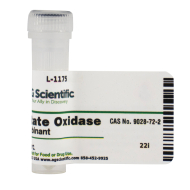Lactate detection and quantification plays a vital role in healthcare, especially in conditions such as hemorrhage, sepsis, tissue hypoxia, respiratory failure and kidney failure. It also has a key role in sports medicine where it is essential in monitoring athletes. Lactate oxidase is an enzyme which is predominantly used in the detection of Lactate. This has led to development of various biochemical sensors and devices utilizing Lactate oxidase.
1. What is Lactate Oxidase?
Lactate oxidase is an FMN (Flavin mononucleotide)-dependent alpha hydroxyl acid oxidizing enzyme. It employs Flavin mononucleotide (FMN) as a cofactor. The enzyme belongs to the family of oxidoreductases, specifically those acting on single donors with O
2 as oxidant and incorporation of two atoms of oxygen into the substrate (oxygenases). Lactate oxidase enzymes appear in viruses and cellular organisms. It is often derived from
Aerococcus viridans.
2. What is the application of Lactate Oxidase?
Lactate oxidase is used in biosensors and in vitro tests in order to detect
lactate e.g. in blood.
3. What is the enzymatic reaction of Lactate Oxidase?
Lactate oxidase participates in pyruvate metabolism. It employs one co-factor, FMN. The enzyme catalyzes the oxidation of
L-lactate to
pyruvate in the presence of dissolved oxygen and forms hydrogen peroxide
4. What is the lab application of Lactate Oxidase?
In clinical medicine it is used for the quantitative determination of
lactate in human plasma. Lactate oxidase catalyzes the oxidation of lactic acid to
pyruvate and hydrogen peroxide. Peroxidase then catalyzes the reaction of hydrogen peroxide with a hydrogen donor, in the presence of 4-aminophenazone, to form a dye.
5. What is the significance of quantitative determination of lactate in human plasma?
Lactate concentration has been widely used in clinical diagnostics for assessing patient health conditions and study of diseases and for continuous surveillance in surgery, sports medicine, and shock/trauma and food industry. The baseline lactate level in blood ranges from 0.5 to 1.5 mmol/l at rest, but can rise up to 25 mmol/L during the intense exertion. Lactate is a key metabolite of the anaerobic metabolic pathway.
6. How is Lactate Oxidase utilized in the quantitative determination of Lactate in Humans?
Lactate oxidase is used for the quantitative determination of lactate in blood plasma. - It is used as a reagent and enzymes in assays. - Due to its ability to catalyze the oxidation of L-lactate to pyruvate, Lactate Oxidase is the principle enzyme used in L-lactate biosensors.
7. What are Lactate Biosensors?
Lactate Biosensors are device assemblies that has a biological element (example enzyme-Lactate Oxidase) and a transducer element that converts variations in physical quantity into current (electrical signal). This current is proportional to the quantity of Lactic acid concentration.
8. What is the molecular weight of Lactate Oxidase?
80 kDa by Gel filtration.
9. Elaborate on the storage and handling information of Lactate Oxidase.
Store desiccated at -20°C. - Keep container tightly closed and in a well ventilated area. - Use only in area provided with appropriate exhaust ventilation. Keep away from heat and - Source of ignition. Empty containers pose a fire risk, evaporate residue under fume hood. - Ground all equipment containing material. Do not breathe dust.
*For best results please store product as per manufacturer's instructions.
10. What is the stability of Lactate Oxidase?
Lactate Oxidase has limited stability. Its finite shelf life becomes inactivated with use. The Stability of lactate oxidase also influences its shelf life when it is used as a reagent or a device. Activity of the enzyme decays quickly when removed from its natural matrix. The Lactate Oxidase obtained from
Aerococcus gets deactivated at temperatures around 65°C.
11. What is the appearance of Lactate Oxidase?
Yellowish lyophilized powder.
12. What are the latest interventions using Lactate Oxidase?
Lactate sensors that utilize lactate oxidase and have applications in sports medicine. It is used to monitor lactate production during exercise. Recently researchers at University of California San Diego have developed a Thin Decal Sensor that is worn on the skin similar to a temporary tattoo that constantly monitors lactate levels in the sweat.
